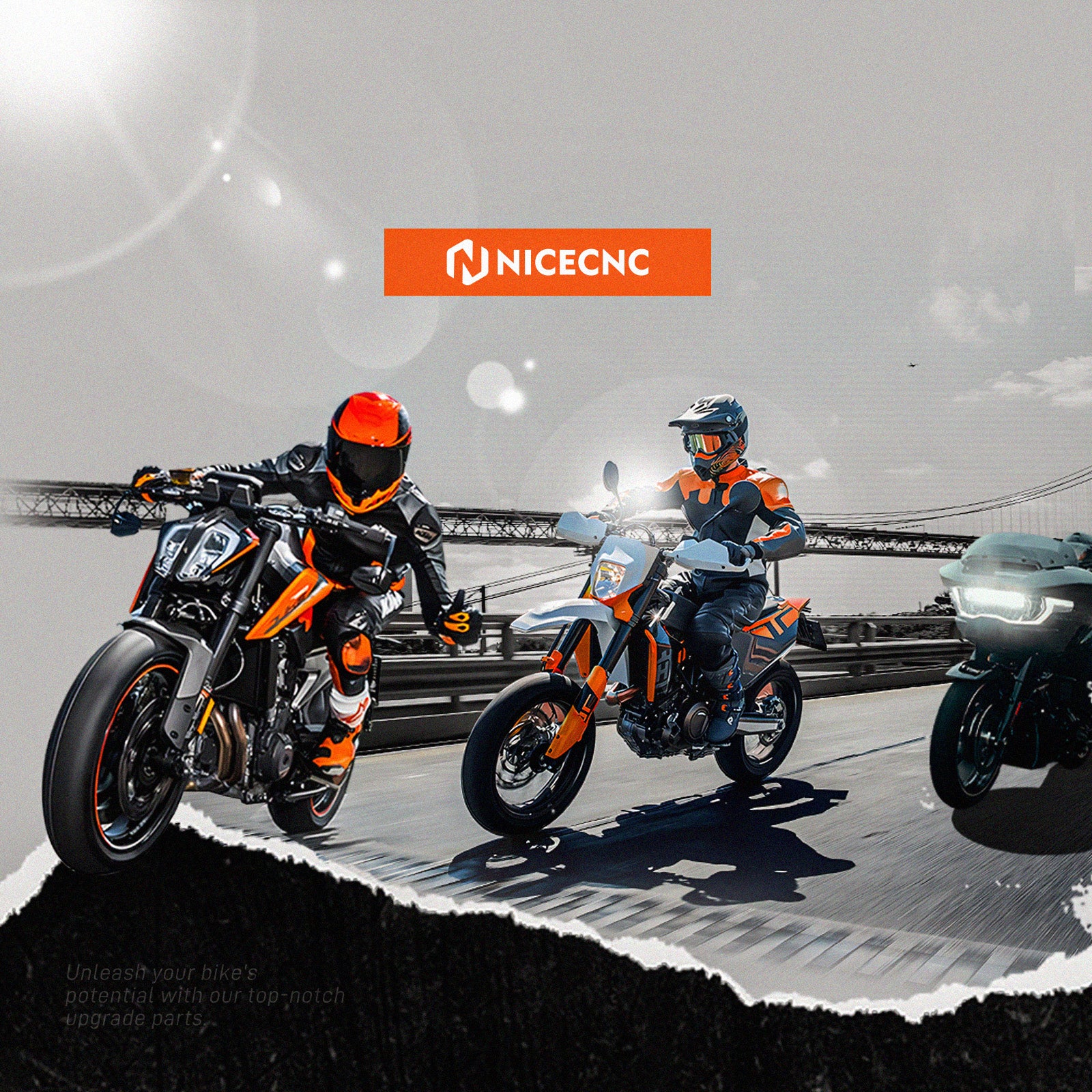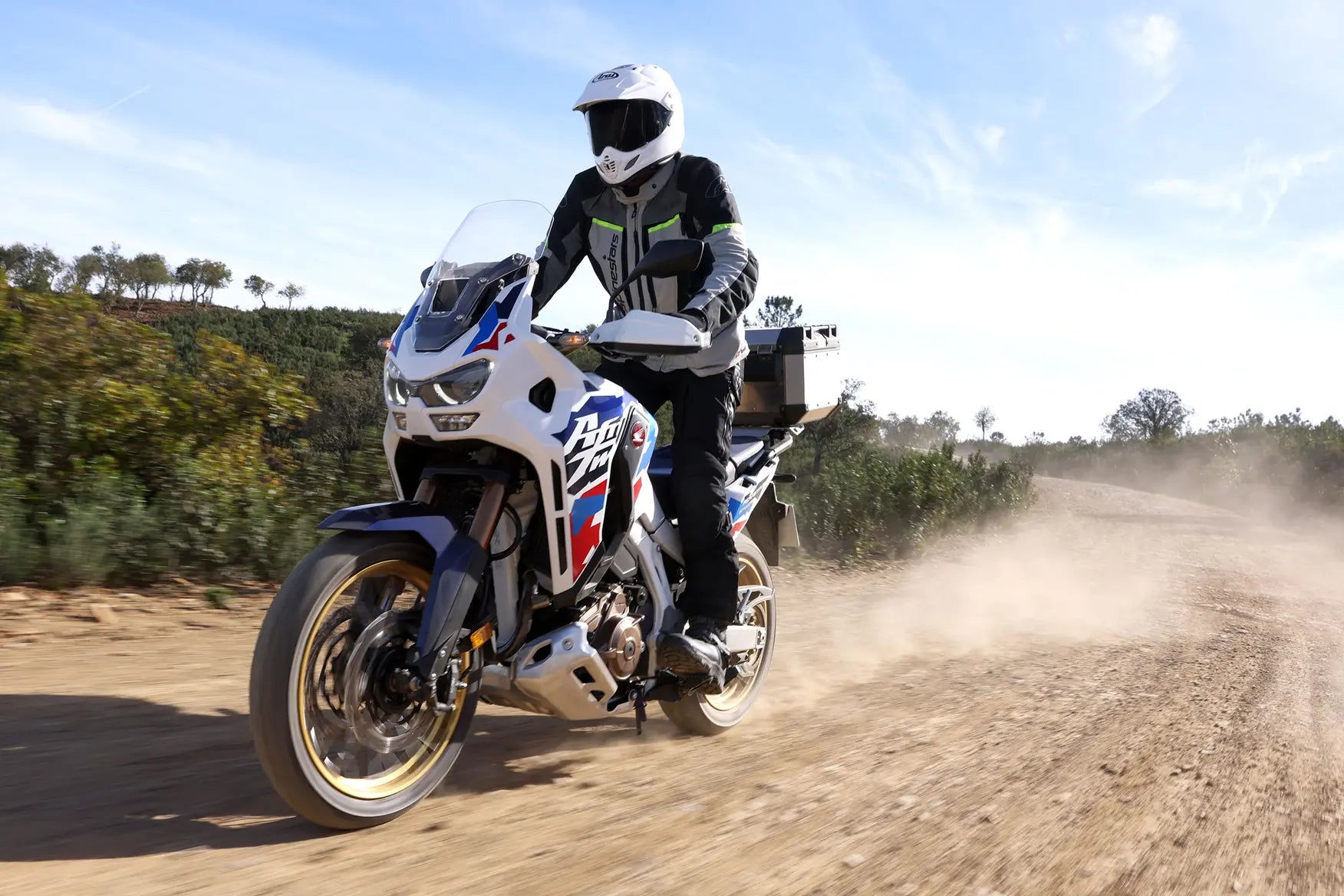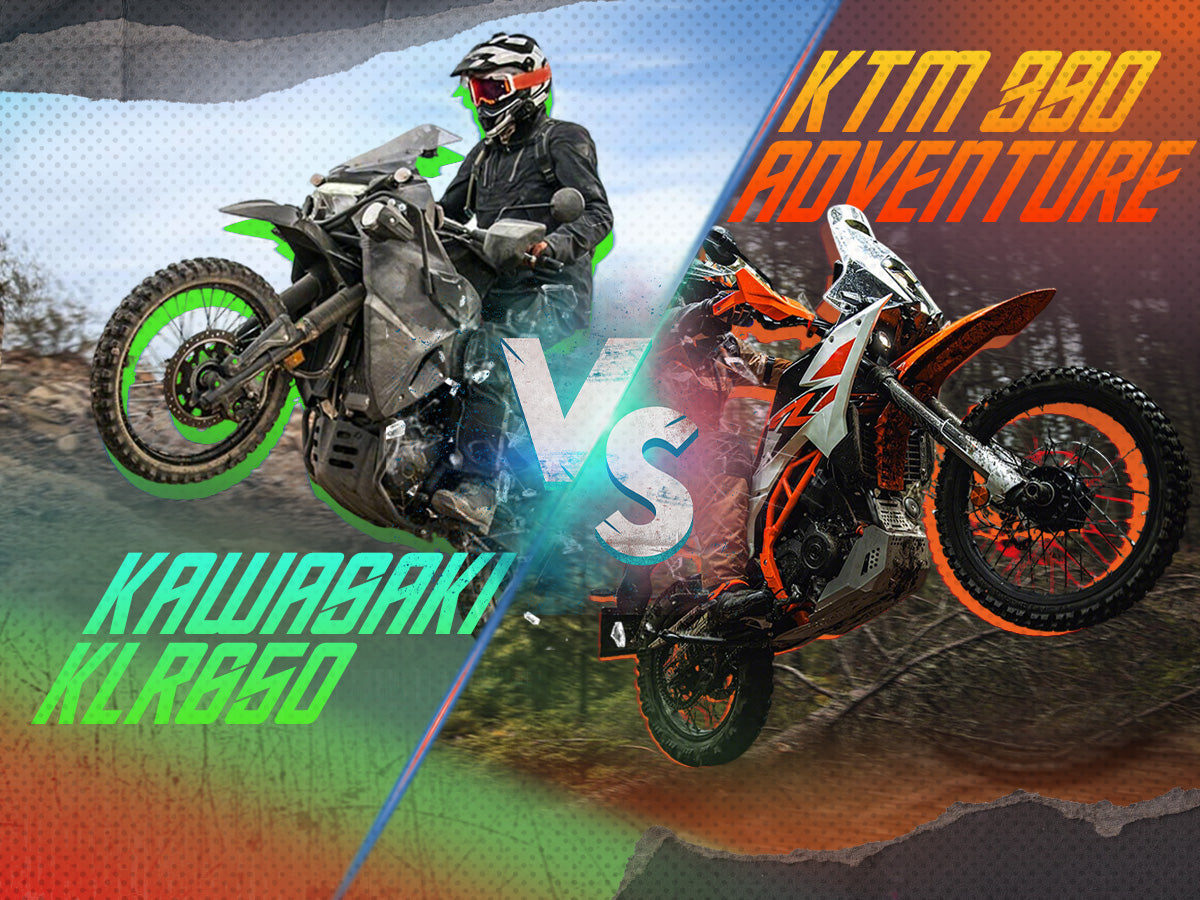Adventure motorcycles are the most capable multi-terrain motorcycles available today — combining long-distance travel, off-road capability, highway stability, and luggage support in one platform. Many riders looking to upgrade in 2026 are now specifically comparing the top ADV models before purchasing — because performance, ownership cost, and real world terrain suitability vary significantly between brands.
This buyer’s guide ranks the 8 Best Adventure Motorcycles to buy in 2026, and breaks down which model fits which type of rider, what terrain each bike performs best on, what compromises each platform has, and what upgrades actually matter. This is designed to help riders make a fast, confident, informed purchase decision.
1. Honda CRF1100L Africa Twin
The Honda CRF1100L Africa Twin is a long-standing favorite for riders seeking balance between on-road comfort and off-road capability. Its 1084cc parallel-twin engine produces approximately 101 hp, delivering smooth torque across a wide RPM range. The optional DCT (Dual Clutch Transmission) version is particularly helpful for riders who want to reduce fatigue on long rides or are transitioning from automatic transmissions or lower-experience bikes.
Advantages:
- Exceptional reliability and resale value.
- Comfortable ergonomics for long-distance touring with seat height 33.2 inches, manageable for riders around 5’9”–5’10”.
- Versatile for both dirt trails and highway cruising.
- Optional DCT reduces learning curve for riders new to multi-mode transmissions.
Disadvantages / Considerations:
- Slightly heavier (~511 lbs wet), can be challenging for technical off-road maneuvers for very light riders.
- Suspension travel is good but may require aftermarket upgrade for extreme off-road use.
- Less electronic sophistication compared to BMW R1300GS; fewer riding modes.
Best for:
Riders seeking a balanced all-rounder that is reliable, comfortable, and relatively easy to manage for first-time ADV owners.
Not recommended for:
Extremely aggressive dirt riders seeking peak off-road performance; heavy fully loaded touring in tight single-track trails may feel less nimble.
Terrain Suitability:
Multi-state versatility — excellent for California desert runs, Colorado trail systems, and Appalachian mountain touring.
Common Upgrade Trends:
Luggage racks, Tail Tidy Fender Eliminator, GPS Mount, Slider Crash Protector
2025 MSRP Baseline:
$14,799 (2026 expected similar range)
2. KTM 890 Adventure
The KTM 890 Adventure is widely considered the benchmark for mid-weight technical adventure motorcycles. Its 889cc parallel-twin engine produces 103 hp with strong low-RPM torque, ideal for off-road maneuvers and highway stability. Adjustable WP suspension and light chassis provide nimble handling in challenging terrain.
Advantages:
- Excellent off-road performance with advanced electronics (traction control, cornering ABS).
- Relatively lightweight for mid-weight ADV at ~467 lbs wet.
- Adjustable ergonomics suitable for riders 5’9”–5’10”.
- Rally variant available for more aggressive off-road use.
Disadvantages / Considerations:
- Less comfortable on long highway rides compared to heavier touring ADVs.
- Taller seat height (~34.5 inches) may challenge shorter riders.
- Maintenance intervals are tighter than simpler bikes like the Tenere 700.
Best for:
Aggressive off-road riders who value technical precision and maneuverability.
Not recommended for:
Riders prioritizing long-distance highway comfort or low-maintenance simplicity.
Terrain Suitability:
Ideal for technical dirt trails, desert dunes, and gravel backroads. Less ideal for slow-speed city commuting.
Common Upgrade Trends:
Lower Larger Footpegs, Rear Brake Disc Guard, Tie Down Brackets, and luggage racks.
2025 MSRP Baseline:
$15,799 (2026 expected similar range)
3. Yamaha Tenere 700
The Tenere 700 is favored in the U.S. for simplicity, durability, and reliability. Powered by a 689cc CP2 parallel-twin engine producing 72 hp, it balances off-road agility and highway touring capability. The lightweight steel frame and long-travel suspension contribute to an accessible, beginner-friendly ADV experience.
Advantages:
- Extremely reliable and low maintenance.
- Seat height 33 inches, comfortable for average U.S. male riders.
- Very capable off-road and on-road balance.
- Lightweight (~430 lbs wet), easy to maneuver for new ADV riders.
Disadvantages / Considerations:
- Fewer electronics and riding modes compared to KTM or BMW.
- Highway comfort is less refined; windscreen and seat may require aftermarket tweaks.
- Limited power for fully loaded touring with passenger.
Best for:
Riders seeking a reliable, easy-to-maintain, mid-weight ADV for trail exploration and weekend adventures.
Not recommended for:
Riders wanting heavy touring comfort or highly electronic-equipped machines.
Terrain Suitability:
Rocky trails in Utah, desert exploration in Arizona, Appalachian backroads.
Common Upgrade Trends:
Handlebar Risers, Rear Grab Handles, Side Luggage Carrier, Front LED Lighting Kit .
2025 MSRP Baseline:
$10,999 (2026 expected similar range)
4. BMW R1300GS
The BMW R1300GS represents the large-displacement premium ADV segment. Its 1300cc engine produces 145 hp, combined with dynamic ESA suspension, multiple riding modes, and advanced TFT display for navigation. It is lighter than the previous 1250GS, enhancing handling without sacrificing touring comfort.

Advantages:
- Premium electronics package for safety and comfort.
- Ergonomic seating (~33.7 inches) suitable for riders around 5’9”–5’10”.
- Excellent long-distance touring capabilities.
- Broad aftermarket accessory ecosystem.
Disadvantages / Considerations:
- High initial cost and insurance.
- Large bike weight (~511 lbs wet) can challenge beginners on technical off-road trails.
- Complex electronics may require learning curve for first-time ADV riders.
Best for:
Riders prioritizing long-distance touring, electronic safety features, and premium components.
Not recommended for:
Riders seeking lightweight maneuverable off-road bikes for technical trails.
Terrain Suitability:
Excellent for cross-country U.S. routes, mountainous touring, and multi-state adventure trips.
Common Upgrade Trends:
Luggage racks,GPS Mount Bracket, cylinder head protection, Skid plate
2025 MSRP Baseline:
$23,645 (2026 expected similar range)
5. Triumph Tiger 900
The Triumph Tiger 900 features a 900cc inline-triple engine producing 93 hp, delivering smooth torque across mid-RPMs. Its chassis offers a mix of sporty road handling and moderate off-road capability.

Advantages:
- Balanced weight (~455 lbs wet) for mid-weight ADV.
- Ergonomic seat height (~32.7 inches) suitable for average U.S. male riders.
- Sportier road handling than typical off-road focused ADV bikes.
Disadvantages / Considerations:
- Less off-road capable than KTM 890 Adventure.
- 2026 updates expected for suspension and heat management.
- Limited passenger comfort for long rides.
Best for:
Riders transitioning from sport or road bikes into mid-weight ADV.
Not recommended for:
Extreme dirt riding or heavy loaded touring.
Terrain Suitability:
Good for U.S. gravel roads, moderate trails, and highway touring.
Common Upgrade Trends:
Suspension spring upgrade, Engine guard, Crash bar protection, USB power expansion
2025 MSRP Baseline:
$15,195 (2026 expected similar range)
6. Aprilia Tuareg 660
The Tuareg 660 is a mid-weight adventure bike with an 80 hp parallel-twin engine, lightweight chassis, and Euro-tuned suspension. It excels at off-road balance and technical agility.

Advantages:
- Very agile (~418 lbs wet).
- Ergonomic for riders around 5’9”–5’10” with seat height ~33.1 inches.
- Excellent off-road handling, especially in tight trails.
Disadvantages / Considerations:
- Less refined for long highway touring.
- Smaller fuel tank (~18 liters) limits long-range touring.
Best for:
Riders focused on trail performance and light touring.
Not recommended for:
Full-time touring riders or those needing maximum comfort and fuel range.
Terrain Suitability:
Rocky trails, forest paths, mountain backroads.
Common Upgrade Trends:
High screen, Upgraded seat, Side stand enlarger
2025 MSRP Baseline:
$12,499(2026 expected similar range)
7. Ducati DesertX Rally
The Ducati DesertX Rally combines 110 hp engine performance with off-road endurance and long-travel suspension. Its lightweight frame (~480 lbs wet) and specialized Rally setup make it ideal for aggressive terrain.
Advantages:
- Premium handling and suspension for technical desert riding.
- Ergonomic seating ~33.8 inches; suitable for 5’9”–5’10” riders.
- High power-to-weight ratio for responsive acceleration.
Disadvantages / Considerations:
- Premium price and higher insurance.
- Not as comfortable for daily commuting.
- Limited aftermarket support in the U.S. compared to BMW or KTM.
Best for:
Riders seeking desert performance or off-road racing inspired setup.
Not recommended for:
Riders prioritizing highway comfort or long-distance touring.
Terrain Suitability:
Arizona deserts, Nevada trails, California off-road adventure areas.
Common Upgrade Trends:
High spec suspension, Lightweight wheel set, Water pump / case protection
2025 MSRP Baseline:
$17,995 (2026 expected similar range)
8. Husqvarna Norden 901
The Norden 901, based on the KTM 890 platform, emphasizes touring comfort while retaining strong off-road capability. Its 105 hp parallel-twin engine, comfortable ergonomics, and adjustable suspension make it a versatile ADV bike.
Advantages:
- Comfortable for riders around 5’9”–5’10” with seat height ~32.6 inches.
- Balanced between performance and touring comfort.
- Premium European build and unique styling.
Disadvantages / Considerations:
- Weight distribution is top-heavy when fuel tank is full. This is especially noticeable for newer adventure riders when picking the bike up solo or doing tight technical switchbacks / steep loose climbs.
- Heated items, comfort touring items, advanced racks / modular luggage ecosystem are less standardized than GS ecosystem. Many owners need to mix multiple 3rd party brands to get the exact configuration they want.
Best for:
Riders seeking a mid-weight ADV with touring comfort and unique styling.
Not recommended for:
Aggressive dirt-focused riders seeking ultimate off-road performance.
Terrain Suitability:
Gravel backroads, mountain passes, multi-day U.S. touring routes.
Common Upgrade Trends:
Skid plates, handguards, luggage racks.
2025 MSRP Baseline:
$14,899 (2026 expected similar range)
How to Choose the Right ADV Bike for You
|
|
|
|
|
|
|
|
|
|
|
|
|
|
|
|
|
|
Seat Height & Ergonomics:
Riders around 5’9”–5’10” will find all eight bikes generally manageable, though KTM 890 Adventure and DesertX Rally are taller and may require toe adjustment or optional lower seat kits for shorter riders.
Maintenance & Cost Considerations:
Yamaha Tenere 700 and Honda Africa Twin offer lowest maintenance costs.
BMW R1300GS and Ducati DesertX Rally are premium machines with higher service costs.
Common first-year upgrades (skid plates, handguards, luggage) are recommended for all models to maximize durability and adventure readiness.
Ultimately, the best adventure motorcycle for you in 2026 is not about peak horsepower, brand prestige, or what the internet says is the most “capable.” It comes down to your real riding environment, the percentage of pavement vs dirt you actually do, your tolerance for weight management, your mechanical comfort level, and how much maintenance commitment you are realistically willing to accept.
For 2026, the midweight category will continue to be the best entry point because these bikes make you want to ride more often, take more risks, learn more skills, and push farther from your usual comfort zone — without punishing penalties when you drop it, scratch it, or stall it on a hill.
Pick based on what type of rider you are becoming — not just who you are today.
FAQ
Q1: Should I buy a midweight 700–900cc ADV or go straight to a 1200+ premium model?
A1: For first-time ADV owners in the U.S., midweights are the better starting platform. They allow learning dirt skills faster, are easier to pick up when dropped, and encourage more exploration confidence. Heavy 1200+ bikes require more experience in low-speed off-road control.
Q2: Do I need DCT (Honda Africa Twin DCT)?
A2: No. But if you struggle with clutch management on steep climbs or in sand, DCT gives you a massive confidence buffer. Many riders transitioning from sport bikes fall in love with DCT after long days off-road. It reduces fatigue.
Q3: What is the single most important upgrade?
A3: Skid plate. Protection before performance. A broken case ruins an entire trip — especially west coast desert riding.
Q4: Tubeless or tube tires?
A4: Tubeless is better for U.S. touring because roadside repair is easier. Tubes have advantages in very aggressive off-road, but tubeless is more practical for most riders.
Q5: How important is seat height really?
A5: It is extremely important for confidence when entering ADV. For riders around 5’9”–5’10”, target seat height ideally under 34 inches until your dirt balance improves. Confidence > specs.
Q6: Is ADV riding more expensive than street?
A6: Yes. Tires wear faster, bike drop probability is higher, and protective add-ons are almost mandatory. Expect slightly higher operating cost per mile.
Q7: What fuel range do I need?
A7: In the U.S., minimum 200 miles per tank is ideal for multi-state touring. Southwest desert riding requires more planning — extra fuel options recommended.
Q8: Which ADV is the best for 2-up riding?
A8: BMW R1300GS → best passenger comfort, luggage stability, chassis for highway miles, and long-distance ergonomics.
Q9: How long does it take to get comfortable off-road?
A9: Typically 3–8 riding days of varied terrain. Momentum + balance + body positioning are more important than raw power.
Q10: Should I buy used or new for my first ADV?
A10: Used is smart if you plan to learn dirt aggressively (because you will scratch / drop). But midweight ADVs hold value extremely well. Honda and Yamaha specifically have strong resale.












